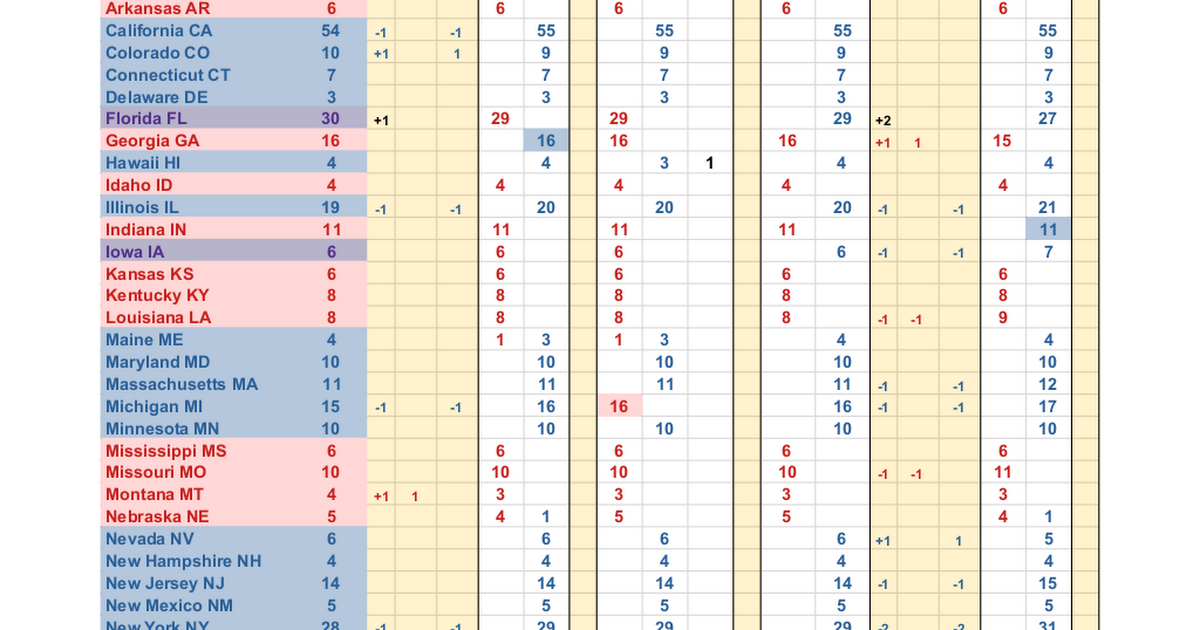After noticing the electoral votes changed for this election from the last in 2020, I counted the change in differences of republican states and democratic states, ignoring the swing states. I noticed republican states gained more votes this time than last, and democratic states lost votes, overall giving republicans more electoral votes for this election. Then I kept on going all the way back to almost the civil war. To me, it seems the electoral college has been favoring red states from 1968 to present time. I want to post this somewhere to get feedback if there is a legit trend (red/right leaning) or I have missed something or anything else.
I tried to color the sheets so they are not too hard to read and understand. I also color coded conservative party as red, and liberal party as blue. There was a party shift between 1960 and 1980, probably having 1971 as the inflection point (WTF happened in 1971?). It was interesting to see some states stay mostly their colors from the remnants of the civil war to present day. You should be able to download the document, if you want.
Also, should I also send this to my representative or would that be pointless, or fruitless?
Red states have always been low population states. Over time every state grows, but the big states were already big. The smaller states have more room to grow, big pop states are more expensive because of the population so grow less.
It’s not some conspiracy, it’s just math. Now the Senate is another thing. There shouldn’t be two Dakota’s for one thing, and New Mexico didn’t have the population to join either.
I’m not entirely convinced that we need one Dakota, let alone two.
We could combine the Dakota’s, Montana and Idaho and almost have 1 state worth of population.
And almost a full set of teeth between them.
Dakontanaho.
Dankan Idaho.
Crushed yet again by the God-Emperor.
Didn’t Canada give up the name “Northwest Territories”? Maybe we can re-use that and no one will notice
Assuming only red states have low population and grows faster is weird, but might be plausible. I could look into historical birth rates of each state, or population changes, comparing them to each other to see if the trends make sense. I assumed (or didn’t think of) there wouldn’t be bias growth rates based on state affiliation (red or blue). My first thought was gerrymandering and could it cause this bias. Either way, I didn’t think about population growth having an inherent bias in this.
That’s weird timing:
I was referencing that website, it kinda lines up around the time the parties switched. The party switch could be another result or part of the cause of that inflection point. I realized there could be connection when I was trying to figure out when the parties switched, but I don’t know enough about that history.
The party switch was because of the Civil rights movement, nothing else.
The south was a single issue region since the beginning, at least for the majority it’s always been racism, for the rest it was corruption or generally selling out their people for whatever the elites could get, like fighting the minimum wage and unions to the death.
So I’d say the death of unions was the turning point, helped by Nixon and the resurgence of the political power of the south with the dixiecrats freed from their quasi-white-socialist ideology following the successes of the new deal.
That’s when my mom became old enough to vote, and she was a real idiot.
It’s not, you know, the best theory, but it’s the best theory I can come up with while also doing no research.
I mean, doesn’t it already bias towards low population red states due to the cap at 538
Electoral College is biased toward low population states, regardless of color. However, yes, rural populations tend to be Conservative
High cost of living in blue states and the resurgence of manufacturing in red southern states has changed the demographics.
https://founders.archives.gov/documents/Madison/01-10-02-0065
There was one difficulty however of a serious nature attending an immediate choice by the people. The right of suffrage was much more diffusive in the Northern than the Southern States; and the latter could have no influence in the election on the score of the Negroes. The substitution of electors obviated this difficulty and seemed on the whole to be liable to fewest objections.
The electoral college was designed from the start simply to let southern states launder slave votes.
The first time the south lost control of the presidency, they rebelled in the Civil War, and they’ve used it to get the presidency or otherwise get power dozens of times.
It’s something the south feels entitled to, an override over the government because they are “The Real Americans” as they wave their confederate flags proudly.
I forgot to add: In determining if the state was red or blue at a change point, I looked at the 4 prior election results, and 2 aft election results, 6 total to determine how red, blue, or tied purple it was for that time. It’s the only fudge factor that could be modified because it’s just a guess, but I think the trend will remain even if you modify this (Ex: 3 prior, 1 aft, 2 prior, 1 Aft, etc.)
There has been a migration from the Upper Midwest and the Northeast since World War II decades of federal money developed other parts of the country to a point where they could sustain private economic development. Since then, there has been a migration to the areas with cheaper cost of living, nearly mirroring white flight from cities to the suburbs.
Recently, California run into issues with development where it to it switched from immigration to emigration.
Your representative likely knows about this.
PSA: anyone who clicks that google docs link is doxxed.
You mean all they’ll know is my email? Not really that drastic…
I don’t want to dox anyone or myself. Is this a google issue or did I link it wrong?





